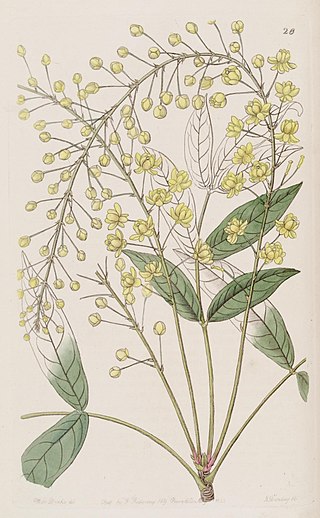
Mahonia is a genus of approximately 70 species of evergreen shrubs and, rarely, small trees in the family Berberidaceae, native to eastern Asia, the Himalaya, North and Central America. They are closely related to the genus Berberis and botanists disagree on whether to recognize a separate Mahonia. Many botanists prefer to classify Mahonia as a part of Berberis because several species in both genera are able to hybridize, and because there are no consistent morphological differences between the two groups other than the leaf pinnation. However, recent DNA-based phylogenetic studies retain the two separate genera, by clarifying that unifoliolate-leaved Berberis s.s. is derived from within a paraphyletic group of shrubs bearing imparipinnate evergreen leaves, which are then divided into three genera: Mahonia, Alloberberis, and Moranothamnus ; a broadly-circumscribed Berberis would also be monophyletic.

Atriplex confertifolia, the shadscale or spiny saltbush, is a species of evergreen shrub in the family Amaranthaceae, which is native to the western United States and northern Mexico.

Mahonia nevinii, known by the common name Nevin's barberry, is a species of flowering shrub in the barberry family.

The Comisión Nacional para el Conocimiento y Uso de la Biodiversidad is a permanent inter-ministerial commission of the Federal Mexican government, created in 1992. It has the primary purpose of coordinating, supporting and executing activities and projects designed to foment understanding of biodiversity within Mexico and the surrounding region. As a governmental agency, CONABIO produces and collates biodiversity data and assessments across Mexico's varied ecosystems. It also either administers or guides a range of biological conservation and sustainability projects with the intention of securing benefits to Mexican society as a whole.
Geissolepis is a genus of flowering plants in the family Asteraceae.

Mahonia fortunei is a species of shrubs in the family Berberidaceae, the barberry family, described as a species in 1846. It is endemic to China, found in the provinces of Chongqing, Guangxi, Guizhou, Hubei, Hunan, Jiangxi, Sichuan, Taiwan, and Zhejiang. It is grown as an ornamental in many lands, with common names including Chinese mahonia, Fortune's mahonia, and holly grape.
Berberis chochoco is an evergreen shrub or small tree up to 9 m (30 ft) tall, in the genus Berberis, family Berberidaceae. It is native to mountainous regions of northeastern Mexico, in the states of Nuevo León, Veracruz, and San Luis Potosí.

Berberis haematocarpa, Woot. with the common names red barberry, red Mexican barbery, Colorado barberry and Mexican barberry, is a species in the Barberry family in southwestern North America. It is also sometimes called algerita, but that name is more often applied to its relative, Mahonia trifoliolata.

Berberis dictyota, now reclassified as Berberis aquifolium var. dictyota, with the common names Jepson's oregon grape and shining netvein barberry, is a flowering plant in the Barberry family.

Berberis bealei, also known as leatherleaf mahonia, Beale's barberry, or Oregon grape, is a species of evergreen shrub native to mainland China. The species has been regarded as the same species as Berberis japonica, native to Taiwan, but the two differ consistently in certain floral and leaf characters. Both species are widely cultivated in many countries as ornamentals. Berberis bealei has reportedly escaped cultivation and become established in the wild in scattered places in the south-eastern United States from Arkansas to Florida to Delaware.

Mahonia gracilis is a plant species native to the Mexico, widely distributed from Tamaulipas to Oaxaca.
Berberis angustifolia is a shrub in the family Berberidaceae, first described as a species in 1840.
Mahonia ehrenbergii is a shrub in the Berberidaceae described as a species in 1847. It is native to the State of Chiapas in southern Mexico.

Berberis tenuifolia is a shrub in the family Berberidaceae described as a species in 1838. It is native to Cuba and Mexico.
Berberis ilicina is a shrub in the Berberidaceae described as a species in 1836. It is endemic to northeastern Mexico, found in the States of Hidalgo and Tamaulipas.
Mahonia zimapana is a shrub in the Berberidaceae described as a species in 1901. It is an uncommon species native to the States of Mexico and Hidalgo in Mexico.
Mahonia incerta is a shrub described as a species in 1901. It is endemic to eastern Mexico, known from the States of Hidalgo and Veracruz.
Mahonia eutriphylla is a species of shrub in the Berberidaceae described as a species in 1901. It is endemic to northern and central Mexico, from Coahuila to Mexico State.









